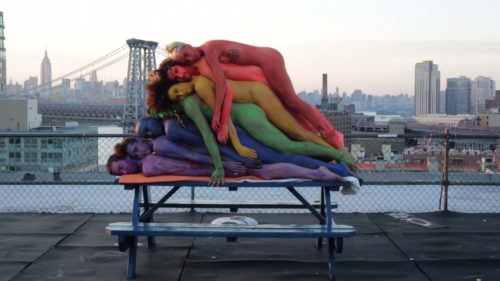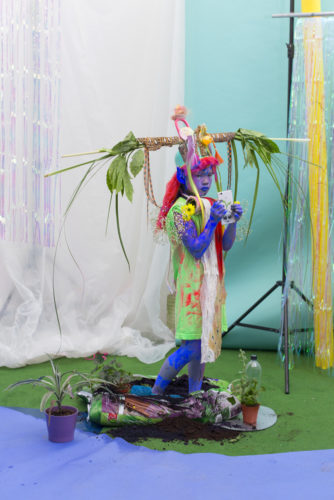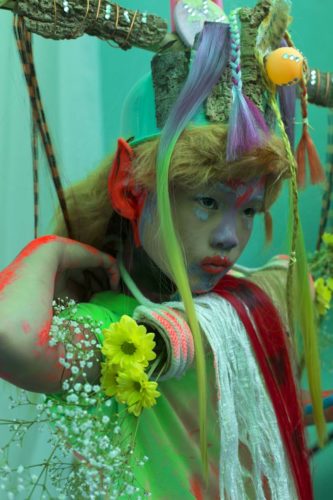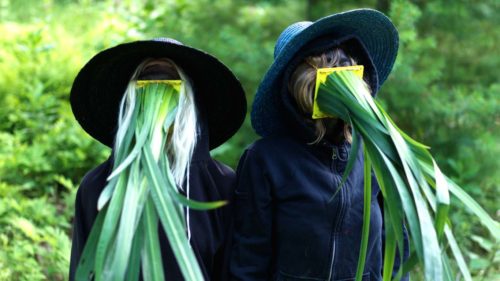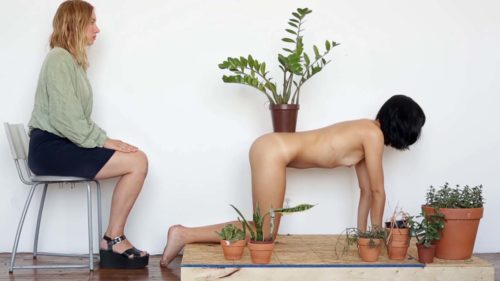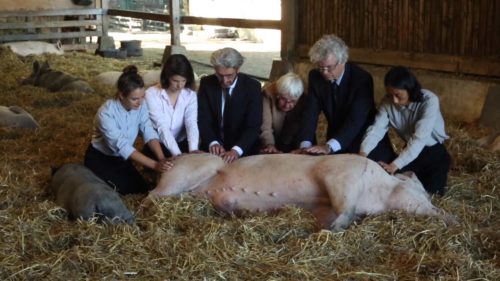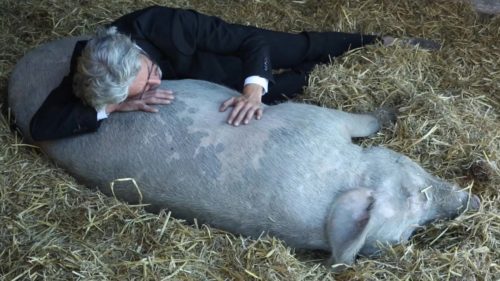KC: In your new film Progress vs. Sunsets (2017), you use the voice of children, the next generation, to center some profoundly fresh insights about animal rights, bio-politics, dwindling global resources, ecology, anthropomorphism, and the general welfare of our planet. How did come to work with youth in this way? Did you have an intuition going into it they would deliver such a succinct and profound message?
MB: This is the 2nd part of the new trilogy focused on marginalized groups on the verge of extinction or in endangerment because of techno-capitalist motivations in relationship to structures of power. In the first I addressed elderly people in relation to social media and technological devices, almost all of them around a century old, asking if these devices improve life and social relations or erode them. It made sense the second part would be around children who are born into this techno-capitalist society in which profit is the number one core value (or that which informs all our other motivations). How do these children who grow up in urban neighborhoods perceive nature and especially animals through funny images on the Internet? When an animal is online often the animal is under endangerment in the wild. The animal becomes sort of like a character or an actor in the human imagination. As soon as that animal steps out of what we imagine the animal to be it’s no longer of value for the human species. The animal takes on an ascribed economic, emotional or entertainment value. These children don’t really know what an animal is. Also what we see in these so-called amateur videos of endangered species and wildlife online is a suppressed anthropomorphism of human and animals. Looking at animals on a basis of similarity instead of differences is coming out in a grotesque way. It opens up an archive of complete confusion and a battle between an objective and a subjective view of the world. What we perceive as elderly, as feminine, indigenous, primitive, emotional or naïve is adultism applied to kids who may be living in a subjective world of interrelation, feeling and emotion. They may live in a more magical world and yet our educational system is so systemized. Creating rationality as a prime core value deprives them from the innate wisdom of the child.
KC: The film’s leading rhetorical question Can we send “funny” animal videos into space for aliens to discover the Earth’s ecosystem? gleefully lambastes the viewer that thinks they can watch this film still running on grown folks’ logic. “Maybe aliens can make humans go extinct to save the animals?” As the video unfolds, the youth continue to virtually trash our noxious me-paradigm culturalisms, teasing out of us the piggish egotism that keeps the Internet widgets moving. “Animals that don’t want to be famous won’t go on the Internet. All people care about is money; it seems more important than life.” I felt like it cracked me open by the end. What was your ah-ha moment in making this film?
MB: What I perceived was a loss of innocence for these kids at an earlier age. Because of the access to information that they have, they are less protected from adult problems – a very complex pool of different polarizing behavioral motivations and thought processes. I see that the children are at an earlier age aware of the ambivalence of what it means to be human and the contradictions of the human and our inherent polarity and darkness. I feel in order to develop a healthy heart and brain structure, there needs to be a space for prolonged innocence. If there is a massive decline of innocence in early childhood based on how we are informed about human behavior through availability of information on the Internet, then that worries me. And then it’s just beautiful to see kids going off into these imaginary spaces and coming up with all kinds of solutions one is only able to come to when one’s mind is free of certain limitations. And also to see how much kids actually care and then to see how hopeless they can feel.
KC: The youth express a counter-mindset grounded in empathy, interconnectedness and altruism, “We don’t want the animals to rely on us in case the humans go extinct. Animals can’t break the law because they are not humans.” How can we continue to fuse art and the views of young people to rattle us robotic adults out of our mental cages? Is there something in particular about art that can catch the most deranged capitalist by surprise?
MB: A quality of art is we can rehearse or download future scenarios through the act of imagination. We can create another story and test it, the art test. As an artist we are in the public realm so if we put out images that are difficult for others, we can say this is a misunderstanding, stupid or ridiculous. We can’t presume that as an artist we are staying in a safe space. The transformative power of art can be to touch upon the points that are painful, or at least recognize the complex construction through which aspects of human complexities such as oppression can or are taking shape. That can lead to difficult conversations, because of the reality we live in. The interconnection is how these images play into social discourse. They are singular points on a larger cultural narrative spinning around subjects, such as racism, sexism, classism; weaving or even just resonating with one another together these sometimes contradicting points exist within a larger network. It is a proposition for transformational politics, where we rethink the imprisonment and isolation we put ourselves in by engaging in a culture where personal gain is the highest value on all costs, leading to supremacist behavior over one another, claims over other peoples’ land and cultures, exploitation of non-humans, economic polarization, flawed mastery and destruction of nature. Meanwhile, most things we really value as humans in our lives are simple and free; less can not only be more, but also just enough. Art is not a fireproof free zone, it is imperfect and will not hit all points of the complex story of human oppression and segregation, it is a dream. It’s also important to support the films with educational programs, workshops, lectures and fieldwork. Change happens on the internal and external level. We have to corroborate how we feel and act, which is according to our values. Surround yourself with people who align with those values and cooperate with them. On the other end, it’s very important that things change on the level of law and economy. With the speed of how things are changing and accelerating, it’s hard to be positive without first there being huge, unavoidable disasters. It’s good to reevaluate how we as groups or as individuals are going to move through that and how are we going to structure ourselves.
KC: Outside of the Western world, where religion has been mostly taken out of schools by law, many believe culture is the meeting of Education and Religion. Here in the United States, what most of us call “Art” boils down to a saccharine popular culture in which whorish corporations are profiteering off of the ghosts of bad religions, post-colonial racial spectacle and disembodied desire. As a student of religion, how do you position yourself as an artist and cultural producer in relationship to the spiritual and the advancement of higher consciousness in womankind?
MB: I think in relation to higher/ collective consciousness, every human is an artist. We all have innate skills to create in alignment with a divine consciousness. We are all creative and creativity is part of creation, the creator and the source. This is the power we all have as humans. How you express that is completely up to you. Maybe you garden, pray, make drawings, sing, dance, write or cook. There are so many ways of expressing creativity with an intention behind it, which can create relationships and also deepen your personal awareness. This is creating spaces that are inclusive and involved. An artistic approach can really give a lot of strength to shaping thoughts into form. Incorporating a spiritual view of the world can offer a sense of support, particularly if there is a space for community to gather and support each other.
KC: Some of us that come from liberal states like California have this damned image of a soccer Mom that went to a weekend workshop, put a feather in her cap and now calls herself a shaman. You said it so well in one interview when you remind us that “In Europe in particular we’ve assisted to hundreds of years of holocaust against female herbalists, exterminating a relation that united a sacred body of knowledge between women, plants and a non-Christian spirituality.” You know, the Dalai` Lama did say, “It will be the Western Women that save the planet.” With so many seemingly white, Western girls going indigenous glam, and perhaps even – causing a revolution in consciousness, how do we address the issue of cultural appropriation? Do we still have to?
MB: I think cultural appropriation in relation to structures of power is real. The systematic oppression of certain people is very real and it’s important that that finally is addressed. There is a lot of punches going here and there and I think that’s good. There’s more visibility now for voices that are typically off the radar – and really struggling relative to those with more privilege – I really want to encourage that. It’s a great, fantastic process. In terms of cultures influencing each other, that’s a process that is valid. Sometimes it’s hard to say what belongs to whom. There exist some basic similarities within all “non-western” traditions that are ascribed to specific groups. People turning away from everyday capitalist western modes are rediscovering things like masks, uses of sticks. There are generic tools that are used in culturally specific ways in specific areas. Structured small societies that used stones, ritual body paint and plants. It’s also just very natural for me as a human to commune with plants. Living in the time we do, it is also natural for me to commune with plastics. I also understand certain ethics at this point are very sensitive and confusing. It’s also an amazing portal to then go into conversation with each other, with people you don’t agree with. Be careful not to attack people who are actually on your side. I think it’s important that we all unite and find the solution together somehow. We should keep talking and holding space for each other’s vulnerabilities, and maybe we should also shut up sometimes. If we live in a globalized culture where many people use global tools, then I think the problem is power and cultural appropriation when profit is a core value. How’s it going for you?
KC: It’s been good (and challenging) for me to really walk through that fire here in NYC. At first it was very jarring, mostly, because I had mountains of racial guilt to move. Then I was all about knowledge as power – unearthing how, as you said, most or all of these traditions actually link us transculturally through our common human origins, which have been intentionally obscured. Then it’s also about bearing witness to people’s anger. And understanding that the truth is a paradox.
MB: With the work that we do, everybody gets hit, but are we the ones to be getting hit?
KC: Exactly, are we artists just beating each other up when we’re all fighting over scraps anyway? Sometimes the fight is a good thing, it’s the fight. But let’s acknowledge the anger, shame, guild, greed – whatever – and circle back to love. It becomes about knowing where the beginning and the end of the emotion is.
MB: When you see cultural appropriation, for example Iggy Azalea – that’s so obviously some form of parasiting – then it’s so painful. In the end, nobody owns anything. We all – in the end – face being naked all alone.
KC: The diversity here in New York also highlights the way in which these issues are positioned to play out power dynamics socially. For instance, as with cyber-bullying or micro-aggressions, they can paradoxically perpetuate the same old cycle of lack and power over, irrespective of race or gender.
MB: On a spiritual level it doesn’t matter. Then it’s just a game that you’re in and how you play it. Some dynamics are definitely more challenging than others. I also think what’s often seen as privilege is complete poverty, loneliness to the core. It’s “privilege” in relation to power and greed, and there’s also poverty in that.
KC: Completely. Your Night Soil/Fake Paradise trilogy explores not only how commodity-based pleasures increase feelings of alienation and cultural malaise within an individual, but how the plant medicine Ayahuasca Amazonian “vine of the soul” is re-defining consciousness transculturally, pushing against the values of capitalism, and waking up our cellular memory of pre-monotheistic ritual belief systems that wove human life into an organic model of the earth. As you explained in another interview, “The knowledge and power to cure come directly from a conversation with the plant…the dimension of the self performs as a direct interface of nature” and optimally this “anti-capitalist medication” activates the body to break out of the trap of techno-modernity “sealed off from nature’s exuberance.” Can you talk about your experiences communing with plants both in terms of imbibing the medicine and just generally keeping their company? Do you have plants at home? Do your plants sing and do you listen?
MB: This is the core practice. The spiritual practice is in the everyday: the details of how you organize your daily life, relate to the people around you, take care of yourself and others, your boundaries. I want to be really careful how I relate to consumption because it’s so dominant and overwhelming. Morally, it’s not the place I usually align with, and yet still depend on for needs like food. It’s also about your thoughts – and how your body is your church, your garden. In terms of plant meditation, I allow plants to be my teachers, they take me to a place of silence and I access portals that are usually only opening with an intensely deep, probably monastery meditation practice. The plants can offer a shortcut to showing divine paths that are – given our western diet and lifestyle – very difficult to reach. It also requires space for integration and a certain slowness. Otherwise it’s this one boost thing that’s not an integrated experience in your personality and in your community. Solidarity and challenging inequities arising along racial, gendered and species boundaries, imagining healthier relationships and simplification of lifestyle resisting identity-related consumerism are really important for me at this point. We want to be so safe that we actually create a very unsafe world. The world is far weirder than the maddest among us. I am not afraid of madness anymore. There is no direct connection between economy and a sense of wellbeing and to take more then we need is a phallusy.
KC: Hunting for a lost female legacy is also a long-term obsession of mine as well #metoo. I think this is a prerequisite of being a feminist artist. I noticed that Night Soil is considered a “semi-documentary.” Having lived that feminist underground life, I’m wondering, is the feminist art community the Black Moon Lilith of the art world or just it’s angry, acne-prone stepsister? I heard during Miami Basel now, if you are not a model, they put a mask on your face. Sometimes I feel like stepping up to bat at all in the Fine Art world is only perpetuating the most ugly forms of elitism and white supremacy masked by the fetishization of Otherness – for sale. And as women looking to be “liberated,” we often end up spinning out of control in a system we only really see in totality when it’s too late (And we’re too old looking to be seen anymore). I’ve seen angels’ ribs cracked like keys on a baby grand and girls shoot Listerine for a buzz. But like you said “Healing is the New Punk.” How do you approach the paradoxes of the MATRIX BONTANICA vision with respect to your own Shadow side as a woman still humbled by the millennial culture psychopathologies?
MB: First of all, I believe it’s important for women to stay in conversation with subjects that are annoying them about other feminist views, as we are all in it for the same ultimate goal – equality. Practice self-investigation where there is judgment towards the approaches, ideas or tactics of others in relation to the common objective of female empowerment and equality among people. It’s important for me that feminism doesn’t align with capitalism. It’s not only feminism but holding the future of the planet safe; it’s important for me to come from that perspective. There may be forms of feminism that seek empowerment through structures of power and wealth and all that which is mostly based on a glorification and commodification of the body and youth – elements that are patented. These are not fundamentally sustainable, core elements such as investing in caring relationships with each other, investing in clear communication with each other, investing in self-care and self-love, investing in reflection. A kind of study in these non-material, non-capitalizing realms of humanity. Every individual is obliged to educate themselves, and mostly that entails making a lot of mistakes. If you put yourself out there in a way that you think is empowering but for others is perceived as naïve or actually tapping into the system, the only thing we can do is give our view and then hopefully, support this person in her own empowerment and respect that journey. No journey is without pain and trouble. What I hear in your question is almost like “Is there a form of purity through which we can bring this message across?” We can contextualize things in the flow and keep fine-tuning them. There is nothing wrong with beauty or youth in itself and enjoying that freshness of the body. I just want to put out there that everybody that is in that just keeps on doing that. Let’s not hide behind judgments against aging. How about outing your vulnerability there –when your body is changing – rather than changing your method? The only way to change the system is looking into your own values and to keep identifying your own relationship to the establishment. Grouping with other people with similar ideas to establish a counter-commentary place. It’s all true – this whole narcissism running as a red line through culture. How are we going to grow old with this as a value? I see it’s a very vulnerable place to be if you put your identity aligned with your beauty and not something sustainable inside.
KC: The last film in the Night Soil trilogy “Nocturnal Gardening” highlights female voices in considering how communities come together through alternative and pre-colonial uses of land in relationship to notions of divinity, sexuality, relational eco-feminism, indigenous land rights and the psychopathologies of late-capitalism. Prior to the influence of white male patriarchal religions the world over, in the time of Mother Rites and rituals, the living connections between human, land and life force were not only acted out in culturally-mandated sacred arts, they were linked to the notion that a human being has a soul that is more than matter and beyond time. How do you hope that the Night Soil dialogue will help to shape urban planning and a more communal ethics with regards to technology and commerce? Is art a fertile ground for the marriage of female leadership, education and the return of the eco-spiritual?
MB: All the women that are voicing their ideas in the films are excellent examples of how this can take shape and how, for example, the belief in a higher spirit (or non-material non-secular presence) is a way for them to feel and be supported in their counter-cultural activist practices. The African American farmers who work with historical land trauma caused by slavery in urban communities or the indigenous rights movement advocate or the woman who works with slaughterhouse animals – all of them work with such tremendously conflicted and immense issues. Limitations of sexism and violence that are for me personally so beyond any type of normality. Having the ability to fight all that with an optimistic approach that is in dialogue with the oppressors – people they disagree with – it’s tremendously inspiring how these dialogues can be held. It’s not just an idea in their head, it’s a practice that’s growing and influencing others. It’s so much bigger I believe than what we can get from our personal source as an individual and almost needs to be fueled by these connections we have all together in relation to spirit or soul or something that is simply bigger than our human understanding. Practicing humility and perceiving the other person as a reflection of ourselves (and in that way also part of ourselves and our environment) – reveals our good side and our shadow. It brings us back to how we create our inside and outside, and that we have responsibility and agency. We have the ability to change.
This article was commissioned by Alexandra Arts for the special print edition of Art 511 Mag celebrating International Women’s Day and the centenary for UK women’s suffrage [funded by ARTS COUNCIL ENGLAND] during the Pankhurst in the Park 2018 season.
